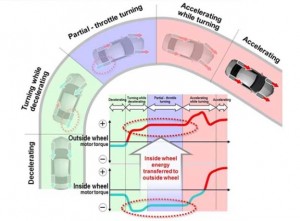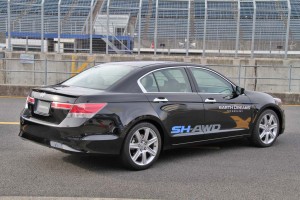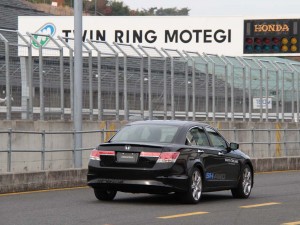It’s been a tough year for Honda: earthquakes, tsunamis, floods, production shortages. And bad reviews. The maker has taken a series of dings from the likes of Consumer Reports, no less, which panned its latest Civic model. In some ways, that’s worse than the sharp downturn in Honda earnings in recent months.
TheDetroitBureau.com spent the better part of a week with mid-level and senior executives, all the way up to President and CEO Takanobu Ito to get an inside look at the company’s turnaround plans – which include a rapid fix of the much-maligned new Honda Civic. But much of the effort revolves around a dramatic transformation of the Honda powertrain line-up. This is, after all, a company that likes to say it’s in the business of building engines, first and foremost.
The new line-up includes both advanced gasoline and alternative propulsion systems – one of the most intriguing being a gas-electric version of Honda’s innovative Super Handling-All-Wheel-Drive system, or SH-AWD, a 3-motor system that we had a chance to take for the proverbial spin on the Twin-Ring Motegi race track a few hours outside Tokyo.
It will serve as a supplement – and perhaps, eventually a replacement – for the purely mechanical SH-AWD system now in use in the Acura RL, TL and MDX models. We also heard hints that an even more high-performance version might be in the works for a sports car application – perhaps something we might be seeing, if rumors prove true, at the upcoming Detroit Auto Show?
“We aim to become number one in all categories of fuel economy within three years,” proclaimed Toshihiko Nonaka, head of automotive R&D, as we arrived at Motegi. CEO Ito would repeat that claim a few days later at he unveiled the maker’s new powertrain line-up at the Tokyo Motor Show under the typically Japanese banner of “Earth Dreams.”
No fantasy this, the SH-AWD hybrid is arguably the anchor of the new powertrain line-up, the system making use of the maker’s new direct-injected 3.5-liter V-6. Yes, Honda has finally relented and accepted the idea that direct injection is a must if it’s to remain competitive on performance and mileage, so you’ll be seeing lots of little DI engines running around, as we’ll get to shortly.
In the prototype we drove at Motegi, the V-6 was tuned to deliver 310 horsepower and 265 lb-ft of torque – or 39 hp and 11 lb-ft more than the current, port-injected Honda Accord V-6. The engine primarily serves as a generator, much the way the smaller inline-four engine works in the Chevrolet Volt extended-range electric vehicle.
As we noted, this is an unusual 3-motor hybrid design. The first is mated directly to the V-6 and turns out another 40 hp and 96 lb-ft. directed to the front wheels through a 7-speed dual-clutch transmission. There are two more motors in back, where the differential would normally sit, one for each rear wheel, making 27-hp and 52 lb-ft each.

This diagram shows how the Electric SH-AWD system operates, directing torque from its V-6 gas engines and three separate electric motors.
The layout is what has come to be known as a through-the-road hybrid, as there is no direct mechanical link between the front and rear axles. There’s also no direct link between the two rear wheels, each powered independently by one of the 27-hp motors. And that’s the breakthrough.
Honda’s SH-AWD is a torque vectoring system. In other words, it applies more power to the outer wheel during a turn to help steer the vehicle around the corner. The current system has to use all sorts of mechanical steps, such as brake intervention, to achieve that effect.
With the hybrid system, or Electric SH-AWD, the car’s computer brain simply applies more power to the outer wheel. It reduces power to the inner rear wheel, which can actually help regenerate electricity sent back to the vehicle’s lithium-ion battery pack.
On paper, it’s a brilliantly simple idea. But we wanted to see for ourselves and took a spin in a modified Accord around the Motegi track. The system made itself known almost instantly on the tight road course Honda engineers had laid out. Charging into the first corner we almost oversteered, not anticipating the helping hand of the SH-AWD system. But the design proved surprisingly intuitive and we quickly grasped what it was doing as we zigged-and-zagged through a slalom run, charging into the final corner before returning to pit lane.
Our short run in the car made it difficult to see if the system lives up to the promise made by Yoshihiro Arai, managing director of Honda’s R&D center that it “achieves equivalent of V-8 performance with better than I-4 fuel economy,” but it is clear that Honda is onto something. The standard SH-AWD system is one of our favorites in the expanding all-wheel-drive universe. If it can really deliver serious performance while actually enhancing mileage it could be the hands-down winner.
The new Electric SH-AWD system can operate in pure electric mode until about 25 mph before the V-6 kicks in. The vectoring feature will operate at speeds up to about 75 mph, according to Honda engineers.
Honda officials stressed that the numbers we saw are still in flux and likely won’t be finalized until the technology actually goes into production, likely starting with the next-gen Acura RL and MDX flagships. And, as we anticipate, there could be other variants of the system under development for even more sporty applications.
The technology will likely be limited to the Acura side of the Honda empire, but there’ll be plenty more new powertrain technology for both the Honda and Acura brands, as we saw during our week with Honda.
Actually, we got a first hint of what’s to come at last month’s L.A. Auto Show, with the launch of the Honda Fit EV, its first pure battery-electric vehicle. But in a Tokyo media roundtable, CEO Ito stressed that he remains skeptical of the market for BEVs and plug-ins, insisting, “I think hybrids will be the largest” sellers among green vehicles for the foreseeable future.
So, count on more hybrids and advanced gasoline models from Honda. On the gas-electric side you’ll start to see a move away from “mild” hybrids, such as the system in the current Insight and CR-Z models, in favor of full hybrid drive systems capable of running at least short distances on battery power alone.
At Motegi, Honda also gave a brief look at some of its other advanced powertrain systems, which will continue to explore opportunities for both hydrogen and natural gas. And diesel, the maker revealing a new 1.6-liter oil burner it says can outperform the current Honda 2.2-liter diesel while also delivering significantly better mileage. It’s a definite for Europe and, in a sharp shift, Honda now intends to test the Japanese market’s interest in diesels. Could a U.S. version be in the offing? Possibly, so stay tuned.
Also expect to see a variety of new direct-injection gasoline engines from the number three Japanese automaker. These range from a 1.5-liter I-4 for the likes of the Fit, up to 2.4-liter four that we’ll be seeing in the next-generation Honda Accord. Look for the production version to deliver near-V-6 power, with a minimum 181 hp, but notably better mileage.
Honda will also adopt an intriguing “two-mode” approach to the engines used in future hybrids. They will be able to switch between the conventional Otto and more fuel-efficient Atkinson cycles depending upon power demands.
Meanwhile, Honda will be introducing three separate CVT transmissions for its new powertrain line-up. The good news is that we found them to suffer from far less of the “rubber band” effect experienced with most of today’s continuously variable transmissions.
With new mileage standards going into effect around the world – and with the competition rapidly getting tougher – Honda clearly had to get back to its roots and show it can lead in the powertrain department. Our time at the Twin-Ring Motegi was too brief to be sure Honda met all its goals but the experience suggests it’s on the right track.


